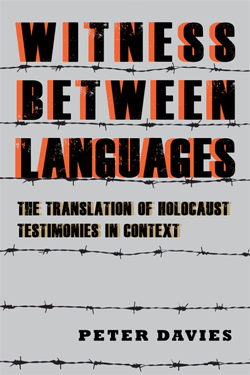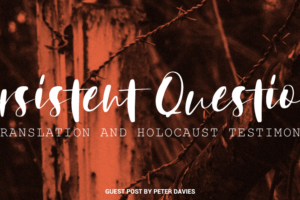Without translation there would be no Holocaust. That’s the conclusion I came to about two-thirds of the way through the research and writing for my book, Witness between Languages. It’s an idea that hit me quite hard when it occurred to me, and I resisted it for a while. It certainly wasn’t what I had set out to show when I started to think about the translation of Holocaust testimony in a fairly unstructured way about ten years ago.
A first light went on during a Masters seminar on Holocaust testimony at the University of Edinburgh, in which a group of students with a variety of linguistic backgrounds started to ask questions of these texts that hadn’t occurred to me before (a particular shout-out goes to Lauren Freede, Veronika Kövér, and Claire Ross). What happens to a text like this in translation? What does it mean for the reader’s encounter with a witness’s words if they are mediated through a translator’s voice? If victims’ experiences in the Nazi death camps are literally indescribable, are they also untranslatable? Is translation as much of a barrier as a window onto the text? Are translators able to withdraw from the text in order to give the reader a direct, unmediated encounter with the witness’s voice in the new language, or are they always present in some way, bringing their own attitudes, emotions, interpretations to the text? Whose voice do we encounter when reading a translation? All of these questions, and many more, crowded in at once, and it became clear that there was not going to be a simple answer. And, most importantly, whatever answer one could find was going to be very uncomfortable.
As soon as I started to talk about these issues, it became obvious that other scholars had been thinking along similar lines: you are never the first one to pose a particular question. I must mention here Andrea Hammel, Jean Boase-Beier, Marion Winters, Sharon Deane-Cox, and Angela Kershaw, who had all been pursuing these questions in different ways for some years, and with whom a very productive ongoing dialogue began. The more we dug into these questions, the more people we discovered who were thinking about them, the more angles and approaches we considered, and the bigger and more unmanageable the project became. Questions, as is their habit, led to more questions.
 As scholars, we can analyze translation strategies, as well as thinking about how the translated text is read and received in the new context. But that very quickly seemed inadequate, and I think, returning to my opening words, there is a more radical conclusion to draw: without translation there would be no Holocaust. The execution of Nazi policy in the countries either occupied by the Wehrmacht or in collaboration with the Third Reich was made possible by an extraordinary range of translation activity, which has only relatively recently attracted the attention of scholars. Structures and practices of power and oppression required translation to function, as did resistance to them: the multinational and multilingual nature of the prisoners and personnel of the later concentration camp system meant that the camps were a particularly intense focus of linguistic mediation and translation[note]Interpreting in Nazi Concentration Camps, ed. Michaela Wolf (London: Bloomsbury Academic, 2016).[/note]. The collection and preservation of knowledge, the circulation of information within occupied Europe and North Africa, and the attempts to bring this knowledge out to the world at large all depended on translation.
As scholars, we can analyze translation strategies, as well as thinking about how the translated text is read and received in the new context. But that very quickly seemed inadequate, and I think, returning to my opening words, there is a more radical conclusion to draw: without translation there would be no Holocaust. The execution of Nazi policy in the countries either occupied by the Wehrmacht or in collaboration with the Third Reich was made possible by an extraordinary range of translation activity, which has only relatively recently attracted the attention of scholars. Structures and practices of power and oppression required translation to function, as did resistance to them: the multinational and multilingual nature of the prisoners and personnel of the later concentration camp system meant that the camps were a particularly intense focus of linguistic mediation and translation[note]Interpreting in Nazi Concentration Camps, ed. Michaela Wolf (London: Bloomsbury Academic, 2016).[/note]. The collection and preservation of knowledge, the circulation of information within occupied Europe and North Africa, and the attempts to bring this knowledge out to the world at large all depended on translation.
But there is more: without translation, we would have no concept that demonstrates the link between a whole range of developments, policies, programs, and experiences of violence, persecution, exploitation, and genocidal murder taking place across a vast geographical area, in different countries, and in a bewildering variety of linguistic cultures. Without the translation of testimonies by victims of the Holocaust, the specific ferocity of the Nazi assault on the Jews as Jews would not have acquired clear contours for those of us living after the genocide. The visibility or invisibility of other victim groups has been affected profoundly by what has and has not been translated. The Holocaust, then, as a concept that emerged in scholarship, commemoration, and political discourse in the decades following the end of the Second World War, has processes of translation written into its structure. We cannot think the Holocaust without also thinking about translation, whether we choose to acknowledge it or not (and mostly, we do not).
We rely on translation to make texts accessible to us that otherwise would not be: imagine, for example, what our knowledge about the Holocaust would consist of in the English-speaking world if we only had access to texts composed in English. Translation is at the core of almost every discussion of the Holocaust in every country, and an army of translators, professional and non-professional, has been at work since the 1930s ensuring that we have access to this knowledge. Family members and community translators and interpreters pass on knowledge, memory, and interpretation down the generations, and mediate between victims, their descendants, and broader society. I must mention here as one example amongst many the work of the translation volunteers at the Wiener Library, London, whose significant translation and digitization project has been an inspiration. Beyond this, court interpreters have made trials possible, historians translate documents or have them translated, memorials present educational material in translation, and testimonies are read in translation or watched with subtitles.
Why, then, have the astonishing achievements of translators so rarely been properly acknowledged? Why has so much of the thinking about translation concentrated on what cannot be done, rather than exploring what can? And why has it taken so long for concrete critical attention to be paid to what happens to these texts when they are translated and read in translation? The field has been expanding since the mid-2000s, with important work being done by Zoë Adams, Zaia Alexander, Sylvia Degen, Ingvild Folkvord, Dorota Glowacka, Piotr Kuhiwczak, Stephanie Munyard, Simone Schroth, Naomi Seidman, Michaela Wolf, and Sue Vice, beyond those I named above. But translation has never been ‘mainstreamed’ in discussion of the Holocaust: it is being established as a legitimate field of study through the commitment of a small number of scholars, but it is still a rather niche interest in conferences, publications, and public discussion of the Holocaust.
My book is an attempt to make the case for the defining importance of translation in Holocaust Studies, to show that something significant is missing if we do not discuss it, and to try to answer some questions. If previous experience is anything to go by, though, I’ll just end up with more questions than I started with. Perhaps another group of students will answer them for me.

I want to finish by setting out some suggestions, perhaps utopian. Not for translators, who have to deal with complex ethical questions under pressure and don’t need any advice from me, but for those who read, use, write about, cite, or publish translated testimonies:
- Always name the translator (#namethetranslator is a hashtag often used by translators irritated by their persistent invisibility). If the name of the translator is not made clear in the texts we are citing, make an effort to track it down.
- Always name the language of the original and provide some information about the circumstances of the translation, where possible.
- Never read a translation as if it were the original text, and don’t talk about the ‘voice’ of the witness without acknowledging the translator’s contribution to it.
- Whether we know the language of the original or not, acknowledge that the translation situation and the aim of the translation may have influenced aspects of the text’s language, structure, or perspective, and at least consider this issue.
- If we ourselves translate even a sentence from a testimony or other source for our work, then always be explicit about what we are trying to achieve with the translation and why.
Too much to ask? To be honest, until consideration of the effects of translation becomes part of the standard methodological armory of scholars writing about testimony, I don’t think so.
